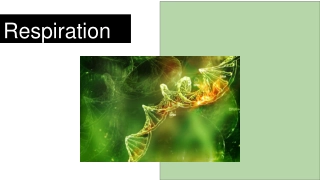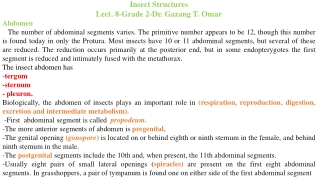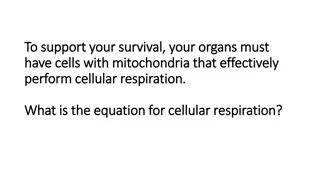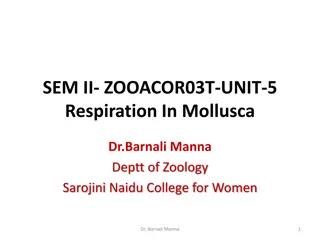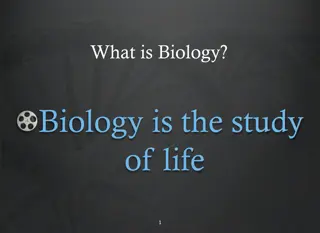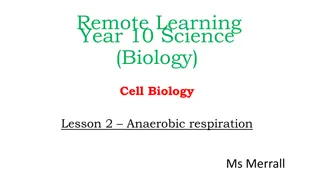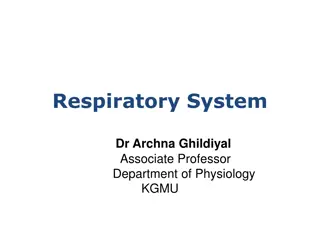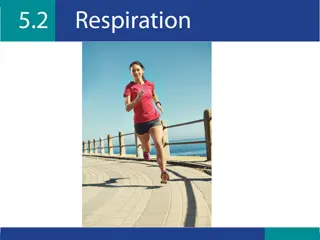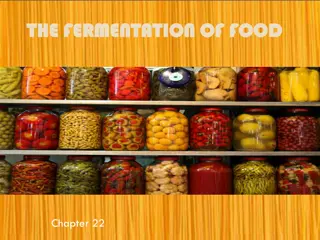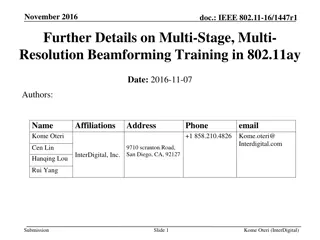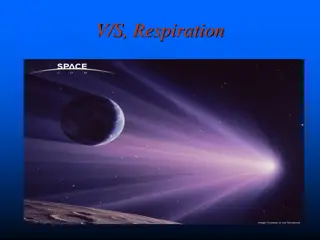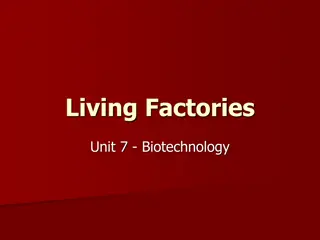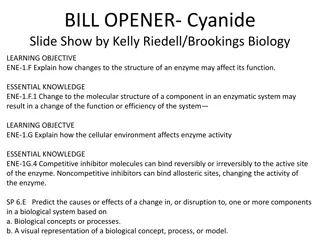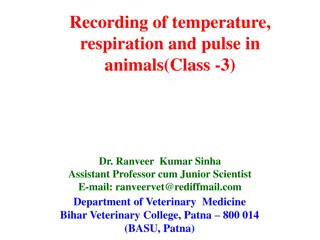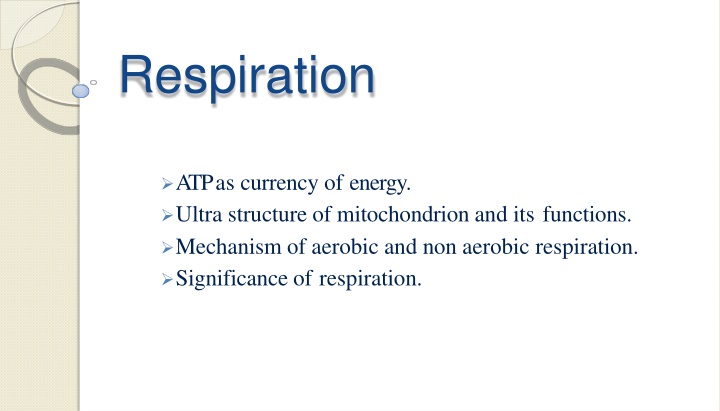
Importance of Cellular Respiration and ATP Energy Currency
Learn about the significance of cellular respiration, the role of ATP as the energy currency, the ultrastructure and functions of mitochondria, aerobic and anaerobic respiration mechanisms, and the types and products of respiration processes. Explore the conversion of organic substances into energy and the overall process of intracellular oxidation for energy release.
Download Presentation

Please find below an Image/Link to download the presentation.
The content on the website is provided AS IS for your information and personal use only. It may not be sold, licensed, or shared on other websites without obtaining consent from the author. If you encounter any issues during the download, it is possible that the publisher has removed the file from their server.
You are allowed to download the files provided on this website for personal or commercial use, subject to the condition that they are used lawfully. All files are the property of their respective owners.
The content on the website is provided AS IS for your information and personal use only. It may not be sold, licensed, or shared on other websites without obtaining consent from the author.
E N D
Presentation Transcript
Respiration ATP as currency of energy. Ultra structure of mitochondrion and its functions. Mechanism of aerobic and non aerobic respiration. Significance of respiration.
Respiration Energyis storedas organicfood in plants. Energy is released when organicfood is oxidised during respiration. Potential energy in food is converted into kineticenergy. Energyreleasing and energy supplyingprocess. The energy released is of twotypes: Heat energy Chemicalenergy
Definition It is an intracellular oxidation process in which complex organic substances are broken down into simpler substances with stepwise release of energy.
Raw materials Glucose Oxygen Product 38ATPsor 686 Kcal or 2870KJ Byproduct Carbon dioxide
Reaction C6H12O6 + 6CO2 Enzymes 6H2O + 6CO2 + 686 Kcal or 38ATP
Overview of Respiration Respiration involves: 1. Gaseous exchange External respiration Internal respiration 1. Catabolic process Exergonic process Formation of water
Types of Respiration 1. Aerobic Respiration The oxidation of the glucose with the help of atmospheric oxygen is called aerobic respiration. + 6O2 6CO2 + 6H2O + 38ATP C6 H12O6 2. Anaerobic Respiration The partial oxidation of organic food in the absence of atmospheric oxygen is called anaerobic respiration. 2C2H5OH + 6CO2 + 2ATP C6 H12O6
Aerobicrespiration Anaerobicrespiration Requires molecularoxygen. Does not molecularoxygen. Respiratorysubstrateis fullyoxidized. Respiratorysubstrateis incompletelyor partially oxidized. End products:CO2and H2O End products:Ethylalcohol andCO2 Exchange of gases between environmentand organism Exchange of gases is notinvolved. Metabolicwater isformed Metabolic water is notformed. Occurs partly in cytoplasmand partlyin mitochondria. Occursentirely incytoplasm. 38ATPmoleculesformed from aglucose molecule. Involve electrontransportchain. 2ATPmoleculesfrom a glucose molecule ETC notrequired. Process runs continuouslythroughoutlifein plants andanimals. Occurs continuously only in some microorganisms.In others it takes place temporaryfor short period duringoxygen deficiency.
Respiratory substrate The organic substances which are oxidized in cellular respiration for releasing energy are called respiratory substrate. a. Carbohydrates: glucose, fructose, starch, glycogen,sucrose. b. Fats: when carbohydrates are exhausted,fats are used as respiratorysource. c. Proteins: used as respiratory substrateunder starvation.
ATP ATP is energy rich organic compound which stores biologically usable form ofenergy. Universal carrier of chemical energy in living world. Energy currency of cells. Energy released when ATP is hydrolyzed to ADPandAMP. ATP + H2O ADP + ip + 7.3 Kcal Energy is stored when ADP & AMP are phosphorylazedto ATP. ADP + ip ATP
ATP -Structure It is a ribonucleotide consisting of 3 components: a. Adenine b. Ribose c. Three Phosphategroups Adenine + Ribose 1st Phosphate group is attached to Riboseand then to each other in a linear fashion. = Adenosine.
ADENINE RIBOSE SUGAR PO4 PO4 PO4 PHOSPHA TE GROUPS ADENOSINE
ATP -Functions Storage of energy. Supply of energy. Minimization of energy wastage. Phosphate groupdonor
Mitochondria Double membrane bounded. Center for aerobic respiration. Present in all living eukaryotic cells. Differ in shape. (filamentous, rod shaped). 0.5- 1 m in diameter & 2-6 m inlength. Colorless
Mitochondria Structure A) Mitochondrial membranes Outer membrane Inner membrane Cristae Elementaryparticles B) Mitochondrial chambers Outer membrane Inner membrane
Mitochondrial membrane oOuter membrane- permeable to certainsolutes. Consistsof 40% lipids& 60% proteins. oInner membrane- consists of 80% proteins & 20% lipids. Selectivelypermeable. oCristae- inner membraneinfoldedinto the matrix. Enclosesa narrow spacecalledintracristalspace. Contains enzymes forrespiration oElementary particles- present on inner surface of inner membrane.Namedas FI particlesor Oxysomes. Range between 104-105in a singlemitochondrion.
Mitochondrial chamber Outer chamber- present between outer & inner membrane.Filled with watery fluidand few enzymes. It temporarilystores ATP molecules aftersynthesis. Inner chamber- central cavity of mitochondrionfilled with more dense, semi fluid, granular matrix. Matrix contains enzymes, DNA,RNA, ribosomes. circulardoublestranded of moleculeDNA. 2- 6
Mitochondria -Functions Power house of cell Intermediate compounds Calcium storage and Maternal inheritance
Aerobic respiration Aerobic respiration is completedin Glycolysis Oxidative carboxylation (Acetylation) Krebs cycle Electron transport system
Glycolysis The sequence of reactions in which glucose (6C)is broken down into two molecules of pyruvic acid(3C). Also called as EMP pathway named after their discoverers Embden, Meyerhoff, and Paranas. 1st step in breakdown of glucose. Does not require presence of oxygen & there is no output of carbon dioxide. Occurs in cytoplasm of cell. Involves series of 10 reaction, each controlled by a specific enzyme.
The reactions are studied in three groups: Activation or phosphorylation of glucose molecule. Cleavage orfragmentation Oxidation.
Activation or Phosphorylation of Glucose 1. Phosphorylation ofglucose Glucose is converted to Glucose 6- phosphate 2. Isomerisation Glucose 6- phosphate isomerised 3. Second phosphorylation Fructose 6-phosphate is phosphorylased to Fructose 1, 6- diphosphate by enzyme Phosphofructokinase(PFK). to Fructose 6-phosphate.
Cleavage or Fragmentation 4. Cleavage Fructose 1, 6 bi phosphate is an unstable compound and splits to produce3C compounds 3PGAL andDHAP. 5. Isomerisation Glycolysis utilizes only PGAL, therefore DHAP is isomerised to 3PGAL
Oxidation 6. Oxidative phosphorylation(Dehydrogenation): 3PGALis oxidized by removal of Hydrogen(H2) and simultaneous phosphorylation Di PGA 7. ATPsynthesis: o 1,3 Di PGA is converted to 3 PGAby release phosphate group. 8. Isomerization: o Phosphate group at 3rd carbon is shifted to 2nd i.e. 3 PGA to 2PGA. o of the product resulting in 1,3 ofone
9. Dehydration: o 2 PGA loses a molecule of water and gets converted to PEPA 10. ATPsynthesis (formation of Pyruvicacid) o PEPA is converted to Pyruvic group. acid by removal of phosphate
Net reaction of Glycolysis 2 C3H4O3 + 2 ATP+2NADH+ + 2 ADP +2NAD+ C6H12O6 H+ Pyruvic acid Net gain ofATP + 2 ATP UTILISED = 8 NET GAIN 6 ATP FROM 2 NADH2 4 ATP BY DIRECT
Fate of PyruvicAcid Glucose Glycolysis Pyruvicacid O2isused O2is not used Aerobic respiration Anaerobic respiration

